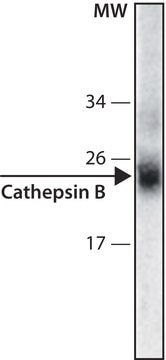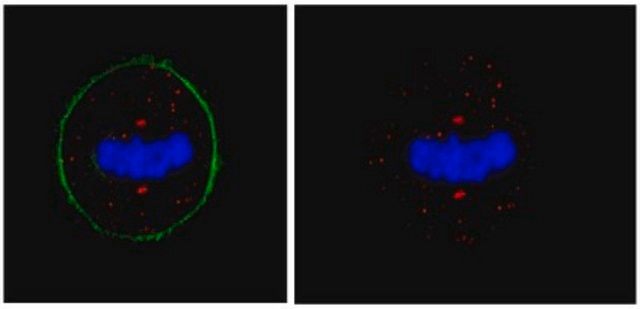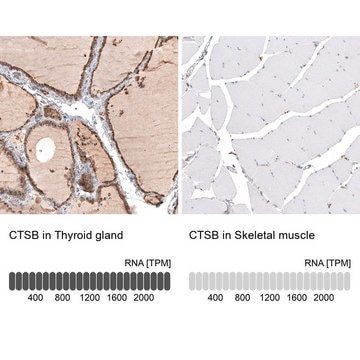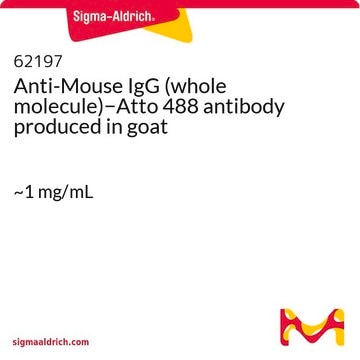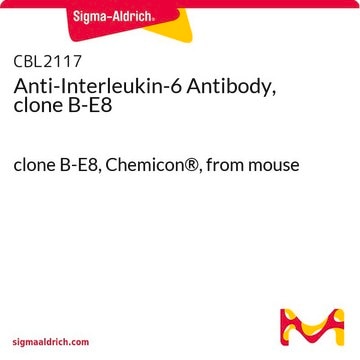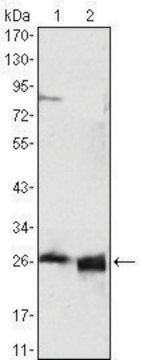IM27L
Anti-Cathepsin B (Ab-1) Mouse mAb (CA10)
lyophilized, clone CA10, Calbiochem®
Sign Into View Organizational & Contract Pricing
All Photos(1)
About This Item
UNSPSC Code:
12352203
NACRES:
NA.43
Recommended Products
biological source
mouse
Quality Level
antibody form
purified antibody
antibody product type
primary antibodies
clone
CA10, monoclonal
form
lyophilized
does not contain
preservative
species reactivity
porcine, human, bovine
should not react with
rat
manufacturer/tradename
Calbiochem®
storage condition
OK to freeze
isotype
IgG2a
shipped in
ambient
storage temp.
2-8°C
Gene Information
mouse ... Ctsb(13030)
General description
Anti-Cathepsin B (Ab-1), mouse monoclonal, clone CA10, recognizes the ~43 kDa latent and ~31 kDa active forms of cathepsin B in HepG2 cells. It is validated for WB, IF, and IP.
Purified mouse monoclonal antibody generated by immunizing BALB/c mice with the specified immunogen and fusing splenocytes with SP2/O-NS1 plasmacytoma cells. Recognizes the ~43 kDa latent and the ~31 kDa active forms of cathepsin B.
Recognizes the ~43 kDa latent and the ~31 kDa active forms of cathepsin B in HepG2 cells.
Immunogen
Epitope: within the heavy chain of mature cathepsin B
Human
purified human liver cathepsin B
Application
Immunoblotting (250 ng/ml)
Immunoprecipitation (1 µg/ml)
Immunofluorescence (see comments)
Immunoprecipitation (1 µg/ml)
Immunofluorescence (see comments)
Warning
Toxicity: Standard Handling (A)
Physical form
Lyophilized from 20 mM ammonium bicabonate buffer, 100 µg BSA (100 µg size) or 20 µg BSA (20 µg size).
Reconstitution
Resuspend the lyophilized antibody with 1 ml sterile PBS. Lyophilized antibodies should be resuspended at 4°C with occasional gentle mixing for at least 2 h. Store at 4°C until reconstituted, then store in aliquots at -20°C or at 4°C with 0.1% azide. Freezing of aliquots is best for long-term storage of reconstituted product. Avoid freeze/thaw cycles.
Analysis Note
Positive Control
Hep G2 cells
Hep G2 cells
Other Notes
Sloane, B.F. 1990. in Seminars in Cancer Biology, ed. M.M. Gottesman. Vol. 1:137-152.
Barret, A.J. 1987. Trends Biochem. Sci.12, 193.
Chan, S.J., et al. 1986. Proc. Natl. Acad. Sci. USA83, 7721.
Barrett, A.J. and Kirschke, H. 1981. Meth. Enzymol.80, 535.
Barret, A.J. 1987. Trends Biochem. Sci.12, 193.
Chan, S.J., et al. 1986. Proc. Natl. Acad. Sci. USA83, 7721.
Barrett, A.J. and Kirschke, H. 1981. Meth. Enzymol.80, 535.
This antibody recognizes an epitope on the heavy chain of mature cathepsin B and therefore detects both mature and pro-cathepsin B. Also reported to work for immunofluorescence. Antibody should be titrated for optimal results in individual systems.
Legal Information
CALBIOCHEM is a registered trademark of Merck KGaA, Darmstadt, Germany
Not finding the right product?
Try our Product Selector Tool.
wgk_germany
WGK 1
flash_point_f
Not applicable
flash_point_c
Not applicable
Certificates of Analysis (COA)
Search for Certificates of Analysis (COA) by entering the products Lot/Batch Number. Lot and Batch Numbers can be found on a product’s label following the words ‘Lot’ or ‘Batch’.
Already Own This Product?
Find documentation for the products that you have recently purchased in the Document Library.
Sonia Boulakirba et al.
Scientific reports, 8(1), 256-256 (2018-01-13)
CSF-1 and IL-34 share the CSF-1 receptor and no differences have been reported in the signaling pathways triggered by both ligands in human monocytes. IL-34 promotes the differentiation and survival of monocytes, macrophages and osteoclasts, as CSF-1 does. However, IL-34
Zhiyu Chen et al.
Cancer letters, 348(1-2), 156-166 (2014-03-26)
The tumor necrosis factor related apoptosis-inducing ligand (TRAIL) causes cancer cell death, but many cancers, including pancreatic cancer, are resistant to TRAIL therapy. A combination of TRAIL and the diterpene triepoxide, triptolide, is effective in inducing pancreatic cancer cell death.
Jun Zhang et al.
Cell death & disease, 8(7), e2954-e2954 (2017-07-28)
Although zinc oxide nanoparticles (ZnONPs) are widely used, they have raised concerns of toxicity in humans. Previous studies have indicated that reactive oxygen species (ROS) and autophagy are involved in the cytotoxicity of ZnONPs, but the regulatory mechanisms between autophagy
Maksim V Baranov et al.
iScience, 11, 160-177 (2019-01-07)
Antigen presentation to T cells in major histocompatibility complex class II (MHC class II) requires the conversion of early endo/phagosomes into lysosomes by a process called maturation. Maturation is driven by the phosphoinositide kinase PIKfyve. Blocking PIKfyve activity by small molecule
Alessandra Romagnoli et al.
Autophagy, 8(9), 1357-1370 (2012-08-14)
Emerging evidence points to an important role of autophagy in the immune response mediated by dendritic cells (DC) against Mycobacterium tuberculosis (Mtb). Since current vaccination based on Bacillus Calmette-Guerin (BCG) is unable to stop the tuberculosis epidemic, a deeper comprehension
Our team of scientists has experience in all areas of research including Life Science, Material Science, Chemical Synthesis, Chromatography, Analytical and many others.
Contact Technical Service